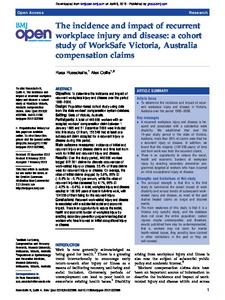The incidence and impact of recurrent workplace injury and disease: a cohort study of WorkSafe Victoria, Australia compensation claims

Ruseckaite, Rasa ; Collie, Alex
2013
3
3
1-7
cost ; notification of accidents and diseases ; occupational disease ; occupational injury ; prevention ; safety and health campaign ; workers' compensation
3
Occupational accidents and diseases
http://dx.doi.org/10.1136/ bmjopen-2012-002396
English
Bibliogr.
"Objective To determine the incidence and impact of recurrent workplace injury and disease over the period 1995–2008.
Design Population-based cohort study using data from the state workers' compensation system database.
Setting State of Victoria, Australia.
Participants A total of 448?868 workers with an accepted workers' compensation claim between 1 January 1995 and 31 December 2008 were included into this study. Of them, 135?349 had at least one subsequent claim accepted for a recurrent injury or disease during this period.
Main outcome measures Incidence of initial and recurrent injury and disease claims and time lost from work for initial and recurrent injury and disease.
Results Over the study period, 448?868 workers lodged 972?281 claims for discrete occurrences of work-related injury or disease. 53.4% of these claims were for recurrent injury or disease. On average, the rates of initial claims dropped by 5.6%, 95% CI (?5.8% to ?5.7%) per annum, while the rates of recurrent injuries decreased by 4.1%, 95% CI (?4.2% to ?0.4%). In total, workplace injury and disease resulted in 188?978?years of loss in full-time work, with 104?556 of them being for the recurrent injury.
Conclusions Recurrent work-related injury and disease is associated with a substantial social and economic impact. There is an opportunity to reduce the social, health and economic burden of workplace injury by enacting secondary prevention programmes targeted at workers who have incurred an initial occupational injury or disease."
Digital
The ETUI is co-funded by the European Union. Views and opinions expressed are however those of the author(s) only and do not necessarily reflect those of the European Union or the ETUI.